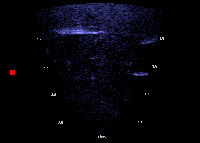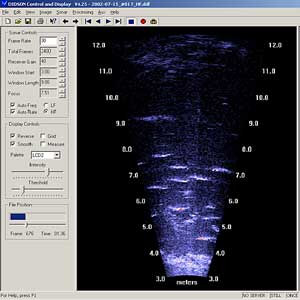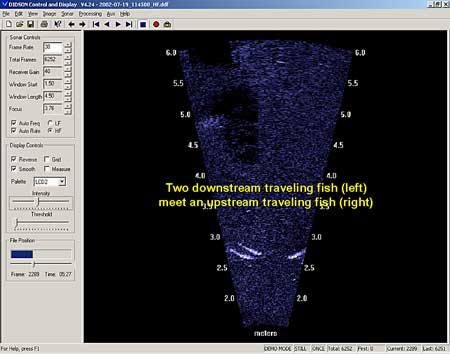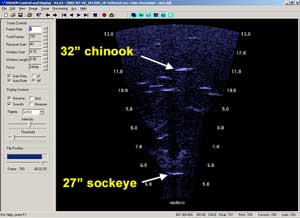Debby L. Burwen - debby_burwen@fishgame.state.ak.us
Alaska Department of Fish and Game
333 Raspberry Road
Anchorage, AK 99518
Suzanne Maxwell (susie_maxwell@fishgame.state.ak.us)
Alaska Department of Fish and Game
43961 Kalifornsky Beach Road
Soldotna, AK 99669
Carl Pfisterer (carl_pfisterer@fishgame.state.ak.us)
Alaska Department of Fish and Game
1300 College Road
Fairbanks, AK 99701
Popular version of paper 4aSP7 - "Investigations into the Application of a
New Sonar System for Assessing Fish Passage in Alaskan Rivers"
Presented Thursday morning, May 27, 2004
147th ASA Meeting, New York, NY
For the last two years, the Alaska Department of Fish and Game (ADFG) has been testing a new sonar system to help count salmon returning to Alaskas rivers. The new system is called a Dual frequency IDentification SONar (DIDSON)(http://www.didson.com). DIDSON was originally developed for the US military by the University of Washington's Applied Physics Lab for diver detection and underwater mine identification and has recently been adapted by ADFG to counting fish in rivers .
 
|
| Figure 1. DIDSON's lensing system (left) produces near video quality images of fish migrating up river (right). |
For over 30 years ADFG has used sonar technology to provide inseason information critical to the management of Alaska's salmon. Fishery managers use sonar information to open and close commercial, sport and subsistence fisheries that intercept these fish. In order to provide more accurate estimates to managers, ADFG is continually testing new sonar technologies that may provide better tools for fisheries research and management (website: http://www.sf.adfg.state.ak.us/region2/sonar/sonar.cfm).
DIDSON uses a sophisticated lensing system to greatly improve image quality (Figure 1). At close ranges, this new class of identification sonar gives near video quality images for identifying objects underwater. The resolution is so high that it is considered a surrogate for optical cameras in very cloudy and silty waters. Because many of the rivers and streams in Alaska are glacially occluded or highly silt-laden, the DIDSON has proven to be a useful tool for observing and counting fish in these turbid conditions (Figure 2).
 |
| View
DIDSON footage of sockeye salmon migrating up the Kenai River. (3.9
MB file) |
| Figure 2. DIDSON video-like images of sockeye salmon migrating up the Kenai River in Alaska. |
Results from experiments in 2002 and 2003 show that the DIDSON provides significant improvements in our ability to detect fish (Figure 3), track fish (Figure 4), and determine the direction of travel of migrating fish (Figure 5) over the more conventional split- and single beam sonar systems currently used at many sites. One drawback to the DIDSON system is its limited range. The current model of the DIDSON provides acceptable resolution and signal strength up to 20m from the transducer. Many of Alaskas streams and rivers are much wider than that. However in 2004 ADFG will test a new long-range DIDSON prototype that should more than double the current model's range.

|

|
| View
DIDSON footage without bottom-subtraction. (5.3 MB file) |
View
DIDSON footage with bottom subtraction. (4.5 MB file) |
Figure 3. One of the advantages of the DIDSON is its ability to detect fish despite an uneven streambed topography which can prevent the use of conventional sonar. DIDSON users can "subtract" all non-moving features (typically the streambed) leaving only the moving fish traces. The frame at left shows an image with the streambed displayed, while the frame at right shows the same image with the streambed features removed. Removing the streambed features allows the fish to be tracked more accurately without interference. |

 |
|
Figure 4. Visually tracking fish images swimming through the 30° field of view of the DIDSON display (left) is easier and more intuitive than with the traditional echogram produced by split and single beam transducers (right) . When there are a lot of fish (more than 5000 fish per hour), the echogram becomes difficult to interpret. |

|
| View DIDSON footage of downstream traveling fish meeting upstream traveling fish. (2.7 MB file) |
| Figure 5. This DIDSON image clearly shows the direction of travel for three fish. In this image two downstream traveling fish (at left) meet a single upstream traveling fish (at right). Downstream traveling fish were also easily distinguished from downstream traveling debris. Direction of travel is essential in rivers where there are many milling fish. |
DIDSON may promise to be a new tool for distinguishing between fish of different sizes, such as chinook salmon and sockeye salmon. Experiments with tethered fish of known size were conducted (Figure 6). We found that reasonably good estimates of fish length could be extracted from short-range (up to 12m) DIDSON images.

|

|
| View
DIDSON footage of a tethered 43" king salmon. (2.2 MB file) |
View DIDSON footage of a tethered chinook and sockeye salmon. (4.6 MB file) |
| Figure 6. At left, is a DIDSON display of a tethered chinook salmon at 3.5m from the transducer. At this range, DIDSON produces exceptionally high-resolution images. At right, is a DIDSON display of a 27" (69cm) sockeye salmon and a 32" (81cm) chinook salmon with numerous free-swimming fish. Notice that as the range is increased, image quality degrades. | |